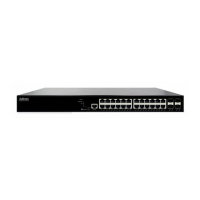SNMP in the NetVanta 1570 SNMP Overview
6AMCCG0018-29A 7
Octets 1 through 4 represent the SNMP private enterprise number (assigned by the Internet Assigned
Numbers Authority (IANA)) for the product manufacturer. The leading bit of octet 1 (the most significant bit) will
always be a 1 for a default engine ID (making the leading character in the hex string an 8). Octet 5 is set to 03
to indicate that the engine ID uses a MAC address as the unique identifier. The last six octets of the default
engine ID for ASE switches contain the MAC address for the central processing unit (CPU) or system (for
example, 800002980300127905257c).
The snmp-server engineID local command overrides the default engine ID and replaces it with the first 24
characters of the user-entered string. Because the string is in hexadecimal notation, only numbers 0 through 9
and letters a through f are valid. If fewer than 24 characters are entered, the rest of the string is padded with
zeros (in the least significant bits) until the 24-character string is complete. For example, a user input of
8000029805 results in an engine ID of 800002980500000000000000.
SNMP Basic Messages
SNMP messages are used by the SNMP agent and network manager to exchange information about MIB
objects. User Datagram Protocol (UDP) port 161 is the default port used to send SNMP messages between
the network manager and the SNMP agent. The NMS can issue Get Request, GetNext, Set, and GetBulk
messages. The SNMP agent can issue Get Response, Trap, Notify, and Inform messages. These message
types are outlined in Table 2.
NOTE
g
If the local SNMP engine ID value is changed, you must save your configuration and reboot the
unit. If rebooting the unit is not feasible, you will need to reconfigure the existing users and
community names in order to apply the SNMP engine ID. Not doing so will result in a loss of
SNMP connectivity. This functionality meets the requirement of RFC 2274.
Table 2. SNMP Messages
Messages Description
Get Request This request is sent by the network manager to retrieve a single item or the first
in a series from a network device.
GetNext
Request
This request is sent by the network manager to retrieve the next item in a series
of items from a network device.
Set Request This command is sent by the network manager to edit information or MIB
value(s) of the SNMP agent (network device).
GetBulk Request This command requests large amounts of data to be transferred within the per-
mitted maximum transmission unit (MTU). The MTU is the largest frame size
allowed on the network without implementing fragmentation.
Get Response This message is sent by the SNMP agent in response to a network manager’s
Get and Set requests.
Trap or Notify This is an unsolicited message issued by an SNMP agent to report an opera-
tional anomaly, or an alarm condition to the network manager.
Inform This message type was created in SNMPv3, and it is sent by the SNMP agent.
The message is similar to a trap, but must be acknowledged by the receiver with
a Get Response message.

